In this week's NewsFlash, we find out why giggling gorillas can tell us how laughter evolved, how shining squid use their entire bodies to see light and how birds learn from their neighbours, but only when the lessons are right. Plus, we speak to the winner of this year's Gruber Prize for cosmology, and Sarah Castor-Perry takes us back to This Week in Science History...
In this episode
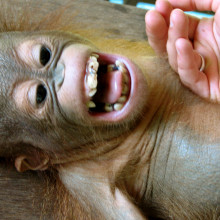
Giggling Gorillas and Chuckling Chimps
Laughter is a wonderful thing to hear - but would you recognise it coming from anything other than a human?
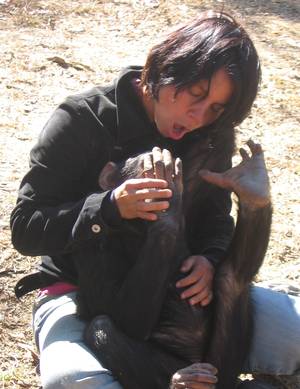 In a delightful study published in this week's Current Biology, Marina Davila-Ross and colleagues at the University of Plymouth have found that what we think of as laughter today could have evolved in our common ancestor with the apes, between 10 and 16 million years ago.
In a delightful study published in this week's Current Biology, Marina Davila-Ross and colleagues at the University of Plymouth have found that what we think of as laughter today could have evolved in our common ancestor with the apes, between 10 and 16 million years ago.
To test this out, they have been listening to the sounds that were made by 21 young apes when they were tickled, and comparing them to the sounds of a human baby being tickled. These sounds were then subject to an acoustic analysis that could detect similarities and differences between the sounds, and importantly judge how closely related the sounds were.
All in all, they analysed 829 recordings, and looked at 11 different acoustic aspects of these sounds, such as peak frequency, the range of frequencies, the number of calls in a bout etc. They also looked at whether the sounds were made on the inhale, exhale or both.
| Gorilla Laughter | Bonobo Laughter |
| Chimpanzee laughter | Human Laughter |
They found a number of similarities, but also some key differences. It turns out that we humans are much noisier than our ape cousins, as the human babies produced significantly more 'voiced' sounds - these are sounds that clearly come from regular vibration of the vocal cords. The human babies also only laughed on the exhale, while the other apes could laugh both when breathing in and out. They were surprised to see that, while laughing, Chimps and Bonobos could effectively control the rate at which they breathe out - that might not seem surprising, but it was thought t be a uniquely human adaptation that allows us to speak.
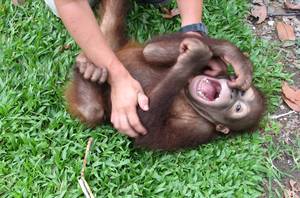 Interestingly, the differences seen for human babies were not one end of a spectrum - these aspects were consistent for the other apes and otherwise, it was actually pretty difficult to tell one species from the next.
Interestingly, the differences seen for human babies were not one end of a spectrum - these aspects were consistent for the other apes and otherwise, it was actually pretty difficult to tell one species from the next.
Next, they put all the data together to create a family tree of laughter and it fit extremely well with a phylogenetic tree, one that shows how closely related species are. Siamang and Orang-utan laughs were more similar to each other than to the other apes, as were Chimps and Bonobos, and humans laugh more like the chimps than the other apes.
It's all too easy to fall into the trap of ascribing human thoughts and intentions to animals - we call it anthropomorphism - but this paper now shows that when an ape is laughing - it's okay to call it a laugh.
But remember don't anthropomorphise animals - they don't like it...
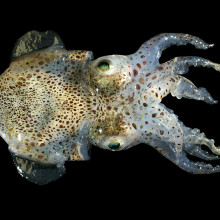
Squid don’t just see with their eyes
Squid, those slippery denizens of the deep, may not only see through their enormous round eyes but it seems they can also detect light all along their bodies as well.
Researchers from the University of Wisconsin-Madison have been studying the Hawaiian bobtail squid. These 3cm long squid have ink sacs on their bellies that don't just squirt out ink but also glow - a process known as counterillumination. When predators look up at the squid from below, the outline of the squid doesn't show up as a dark silhouette but instead blends into the bright background of the oceans' surface. Margaret McFall-Ngai and her team publishing in the journal PNAS have discovered that these ink sacs are capable of not just emitting but also detecting light.
A type of bioluminescent bacteria called Vibrio fischeri live inside the squid ink sacs in a two-way symbiotic relationship that benefits both squid and bacteria. The bacteria help the squid camouflage themselves against the bright ocean surface and in return, the bacteria get a safe place to live with all the nutrients that they need.
The bacteria emit a constant glow but the squid can control how much of that light escapes by changing the shape of the ink sac tissues, rather like the iris can let more or less light into an eye. The squid ink sac even has a transparent layer across the surface that acts like a rudimentary lens controlling the direction of the emitted light. By letting more or less light through from the bacteria, squid can match themselves to the brightness of the sea surface that varies depending on how deep down they are and what time of day it is.
The question is, how do the squid know how light the ocean is around them? It now seems that they might not only use their eyes, but the ink sacs also have a role to play in detecting ambient light.
McFall-Ngai have discovered that the ink sack tissues housing the luminous bacteria contain genes that produce proteins associated with light detection, including some similar to ones found in the retina - the light detecting layer of cells in the eye. They also hooked up an ink sac to an electroretinogram - electrodes that are usually used to measure the electrical responses of a retina when light is shone on it. They found similar electric signals were generated by the squid ink sac, indicating that it is sensitive to light.
The researchers don't yet know exactly how these second light-receptors evolved. It could be a form of genetic or evolutionary "tinkering", a technical term in which existing components of a living system are reassembled and tinkered and put to use in new combinations or locations. More studies are needed to delve deeper into exactly what is going on.
This study sheds light into a remarkable symbiotic relationship between bacteria and large animals, something that is particularly important for us humans to understand since we rely on trillions of bacteria living inside us to keep us healthy. We may not glow brightly at night, but eight out of ten of our major organs have some sort of bacteria living in them.
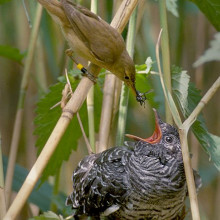
11:56 - Warblers Learn who to Trust
Warblers Learn who to Trust
Back in February, I reported on a paper in the journal Current Biology about how Reed Warblers protect themselves from being parasitised by cuckoos...
Now, in a follow up paper published in this week's Science, Nick Davies and Justin Welbergen from Cambridge University have found out how the birds learn how to defend themselves by watching their neighbours.
Cuckoos are a problem because they lay their eggs in other bird's nests, and then leave the host birds to bring up their young. This wastes a lot of energy for the reed warblers, but there's no advantage for them. As a result, they've evolved a tendency to mob cuckoos, which makes them less likely to end up bringing up someone else's chicks, even though it's a costly behaviour in terms of energy and it risks exposing the Warblers to predators.
Well when the Warblers mob, they make very loud calls and snap their beaks with a loud clicking sound. They also swoop down at the cuckoos, directly attack them and generally get in a flap.
In the new paper they present evidence as to how the Warblers learn when to mob, and when not to mob - as it's a bad idea to waste your efforts mobbing a bird that isn't a threat. Armed with a model of a cuckoo and a model of a parrot (acting as a novel but non threatening stimulus), they set about observing how different birds responded to each.
After establishing a baseline for how each set of birds reacted, they allowed the birds they studied to see how neighbouring birds reacted to the models. If the birds are learning through social stimulus, they said, then mobbing would only increase in response to the model that their neighbours mobbed.
They found that when the neighbouring birds mobbed a model parrot, it made no difference to how likely the focal birds (the ones being studied) were to mob either the cuckoo or parrot models. However, when a cuckoo was mobbed nearby, the rates of cuckoo mobbing greatly increased.
In fact, the naive birds that did not mob a cuckoo on their first exposure started mobbing only after watching their neighbours do so. This is probably because female cuckoos have a certain area in which they will lay eggs, and so a cuckoo in a neighbour's nest suggests a realistic threat.
This suggests that the Warblers are primed to learn new behaviours only when they respond to genuine threats - a tendency also seen in macaques, who learn to be scared of snakes, but can't be taught to be afraid of rabbits!
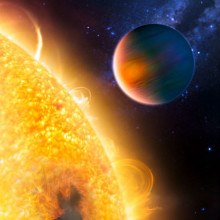
15:34 - The Gruber Prize for Cosmology
The Gruber Prize for Cosmology
Robert Kennicutt, Director of the Institute of Astronomy at the University of Cambridge
Ben - Also in the news this week, the winners of the Gruber Prize for Cosmology have been announced. This is the tenth anniversary of the Cosmology Prize, and this year it's shared between three winners:
Wendy Freedman - director of the Observatories of the Carnegie Institution of Washington in Pasadena, California
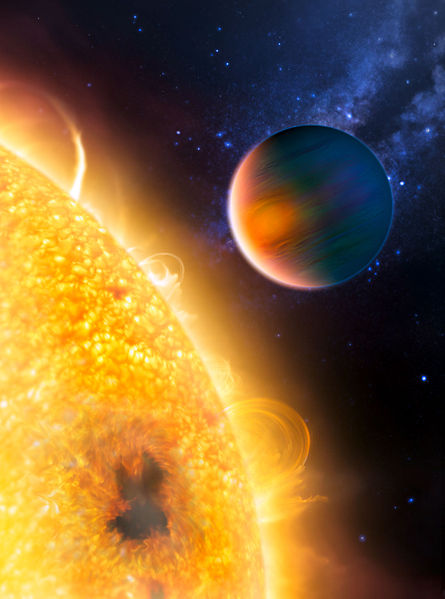 Jeremy Mould, professorial fellow at the University of Melbourne School of Physics.
Jeremy Mould, professorial fellow at the University of Melbourne School of Physics.
And Robert Kennicutt, Director of the Institute of Astronomy at the University of Cambridge in England.
They're sharing the $500,000 prize for leading the teams that measured the value of the Hubble constant - the rate at which the universe has been expanding since the Big Bang.
We're joined by Professor Robert Kennicutt now. Hi, Robert. Thanks for joining us.
Robert - Thank you. Happy to be here.
Ben - You must be really pleased to see your work recognised by such a prestigious award.
Robert - Indeed. The phone call was quite a surprise but the work was very influential. It was done about ten years ago. I think the organisers of the prize were waiting to see if we'd gotten the right answers or not. In any case, it was delightful to have it recognised in the way it was.
Ben - I can imagine. What is so important about this number, the Hubble constant.
Robert - Yeah. The measurement actually ties into the whole series of experiments that your listeners have probably heard about over the last decade to try to characterise the expansion history of the universe. Our measurement actually provides some very basic numbers: how large is the universe? What is the distance scale? In fact it actually provides a measurement of the age of the universe. Moreover when you combine it with other measurements of the supernova, high red shift, it actually was the work that provided this strong evidence for dark energy in the universe and this expansion. These experiments all tie together and yield consistent results. This was one of the cornerstones of that series of experiments.
Ben - Without this research we wouldn't be asking the questions that we're asking today. It really was a major step forward in understanding out universe.
Robert - That's right. I can give a simple analogy. The measurements that established the existence of dark energy actually tell us how the expansion rate of the universe has changed. It actually slowed down and has sped up over time whereas we're measuring the absolute scale. It's actually a difficult measurement. For example, if you've looked at the television in the last couple of days you've seen the images of Barack Obama standing next to Nicholas Sarkozy and Gordon Brown. You can instantly when you look at the screen tell which of these people is the tallest. Obama is the tallest and you can even get, when they stand next to each other, get some idea whether he's 20% taller or 10% taller. It's very difficult when looking at the monitor to have some idea how tall these people actually are; whether Obama's six feet tall or six-and-a-half, five foot eight and so on. That's our experiment - really to see by measuring relatively nearby galaxies and providing the yardstick next to these galaxies to measure the exact distance, the quantitative distances and the scale of this whole expansion.
Ben - Will it also help us to understand what the ultimate fate of the universe will be. If we can understand its history then surely we can predict a little bit more about its future.
Robert - Indeed. Prior to this work these distances were only known to a factor of 2 accuracy. The best measurements of the time gave an age of the universe, derived from the expansion, was younger than the ages of the oldest stars we could measure using other techniques. The result of these measurements, combined with the more distant supernova cosmology experiments, actually led to several independent measurements of the cosmic age scale. We've actually determined the problem and remarkably these measurements have come into almost exact concordance and it's almost unsettling, in fact. Scientists, especially astronomers, are not used to precise agreement. The term "precision cosmology," which is a new term is something we're still getting used to. The result of that is - the implication of that is the universe of the future's actually going to speed up its expansion over time as this dark energy becomes more and more important a force in driving the expansion of the universe.
Ben - So how did your teams actually measure it? It seems like a difficult thing to come up with.
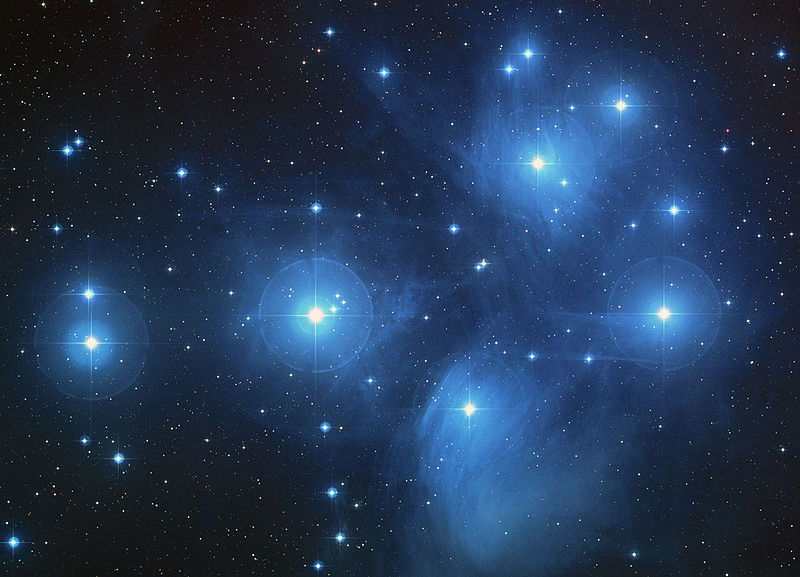 Robert - It actually boils down fairly mundane elements. What we want to do is survey distances to galaxies. We want to measure how far they are away in miles and kilometres precisely. The key instrument that enabled this breakthrough was the Hubble Space Telescope. The key technique we use is a class of variable pulsating stars called cepheid variable stars whose brightness can be measured accurately when you measure their period of oscillations. Hubble actually had the resolution to be able to identify these stars in galaxies at distances of up to 50 or 100,000,000 light years. A light year is six trillion miles. These are vast distances. We essentially laid out twenty benchmarks in distances in the local universe. We were able to measure not only the local expansion but how that expansion actually changes with distance. We live in an over-dense part of the universe that has affected the local expansion. We had to calibrate that out as well. So you can think of this sort of as being surveyors laying out benchmarks and establishing a scale. The result was accurate to about 10% at the time. Since then other techniques using cosmic microwave background have repeated their measurements completely independently and the two sets of results actually agree within a few per cent. We're quite sure we've got it right.
Robert - It actually boils down fairly mundane elements. What we want to do is survey distances to galaxies. We want to measure how far they are away in miles and kilometres precisely. The key instrument that enabled this breakthrough was the Hubble Space Telescope. The key technique we use is a class of variable pulsating stars called cepheid variable stars whose brightness can be measured accurately when you measure their period of oscillations. Hubble actually had the resolution to be able to identify these stars in galaxies at distances of up to 50 or 100,000,000 light years. A light year is six trillion miles. These are vast distances. We essentially laid out twenty benchmarks in distances in the local universe. We were able to measure not only the local expansion but how that expansion actually changes with distance. We live in an over-dense part of the universe that has affected the local expansion. We had to calibrate that out as well. So you can think of this sort of as being surveyors laying out benchmarks and establishing a scale. The result was accurate to about 10% at the time. Since then other techniques using cosmic microwave background have repeated their measurements completely independently and the two sets of results actually agree within a few per cent. We're quite sure we've got it right.
Ben - That's astounding. So finally, the prize money shared between the three of you - will that go into more scientific research or are you planning a well-deserved treat?
Robert - You're not the first person to ask. These important decisions take time, you must understand.
Ben - Of course!
Robert - I'm not going to buy a supercar. I'm not going to give it all to charity but we are going to spend some of it on one major party for the team.
Ben - Wonderful. Just in case you happen to be doing the invites at the moment you can write to The Naked Scientists at Cambridge University. But no, of course, we wouldn't expect an invite...
Robert - I don't know. I'm a fan of the show so who knows!?
Ben - Wonderful. I'll keep an eye on the post. Thank you so much for joining us, Robert. That was Professor Robert Kennicutt, he's the Director of the Institute of Astronomy at Cambridge University and along with Wendy Freedman and Jeremy Mould he's just been awarded the Gruber Foundation's Cosmology Prize for measuring the rate of expansion of the universe.
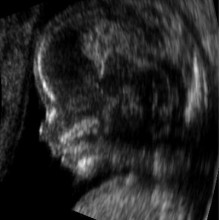
23:07 - This Week in Science History - The Birth of Ultrasound
This Week in Science History - The Birth of Ultrasound
Sarah Castor-Perry
This Week in Science History saw, in 1958, the publication of a significant paper that began the use of ultrasound as a diagnostic tool in medicine. It was published by the Scottish obstetrician Professor Ian Donald and his colleagues in the Lancet, and is seen as one of the most important papers in medical imaging history.
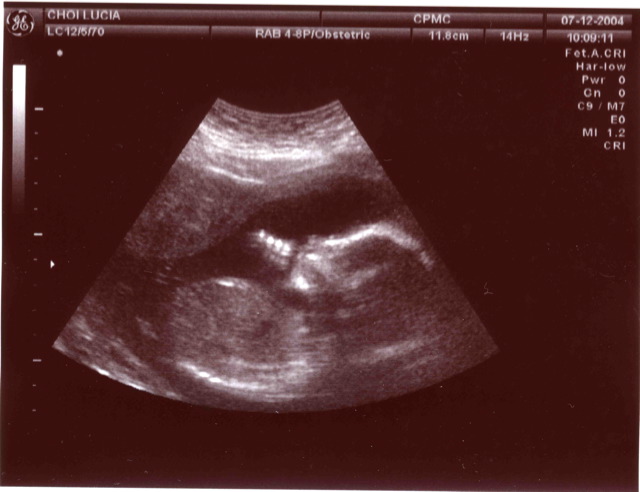 Ultrasound waves are sound waves of a much higher frequency than we can detect - humans can hear up to around 20 kilohertz, but medical ultrasound operates at between 2 and 18 megahertz. In modern ultrasound machines, the sound waves enter the body from the probe containing an acoustic transducer, which produces the sound waves. These enter the body and bounce back off the internal organs in different ways depending on their density, coming back to the detector as an 'echo'. The time taken for the echo to travel back to the detector allows the depth of the object causing the reflection to be calculated. Solid objects bounce back a different signal to liquids, which is why it is easy for this technique to 'see' a foetus in the womb, full of amniotic fluid.
Ultrasound waves are sound waves of a much higher frequency than we can detect - humans can hear up to around 20 kilohertz, but medical ultrasound operates at between 2 and 18 megahertz. In modern ultrasound machines, the sound waves enter the body from the probe containing an acoustic transducer, which produces the sound waves. These enter the body and bounce back off the internal organs in different ways depending on their density, coming back to the detector as an 'echo'. The time taken for the echo to travel back to the detector allows the depth of the object causing the reflection to be calculated. Solid objects bounce back a different signal to liquids, which is why it is easy for this technique to 'see' a foetus in the womb, full of amniotic fluid.
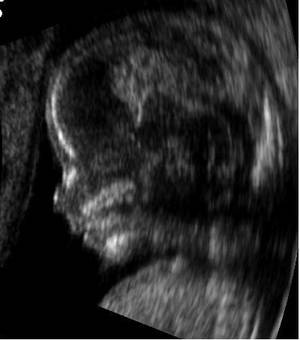 Most people would recognise (or may have experienced) the use of sonography during pregnancy to image the baby, but it is also used as a diagnostic tool elsewhere in the body such as imaging organs like the bladder and prostate in men to check for abnormalities like tumours. Other forms of ultrasound can be used therapeutically, and in fact this was developed before ultrasound's imaging capabilities were realised, to clean teeth at the dentist, to treat cataracts and even used to treat benign and malignant tumours.
Most people would recognise (or may have experienced) the use of sonography during pregnancy to image the baby, but it is also used as a diagnostic tool elsewhere in the body such as imaging organs like the bladder and prostate in men to check for abnormalities like tumours. Other forms of ultrasound can be used therapeutically, and in fact this was developed before ultrasound's imaging capabilities were realised, to clean teeth at the dentist, to treat cataracts and even used to treat benign and malignant tumours.
Professor Donald had served in the Second World War, where he gained knowledge of radar and sonar. He theorised that something similar to sonar could be used to look for abnormalities in the human body, and in 1955 visited the boilermakers Babcock and Wilcox to use their industrial ultrasound equipment usually used to check for flaws in sheets of metal. He took various sorts of cysts and tumours extracted from patients at his hospital to see if they could be differentiated from each other and from normal tissue like muscle (using a steak!). He had some limited success, but recognised the technique's potential, so collaborated with Tom Brown, a medical physicist, and John MacVicar, another obstetrician, to refine the technique. Their experimentation and results in examining abdominal 'masses' (like tumours and cysts) were what came to be eventually published in the Lancet paper. It was after this that Donald recognised the use of sonography in measuring foetal growth my measuring the dimensions of the head in utero.
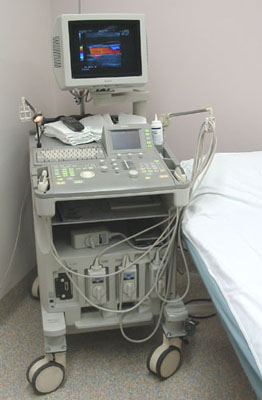 Within a decade of the publication of the paper, the use of ultrasound had moved into the mainstream and had already improved. As Donald himself said 'any new technique becomes more attractive if its clinical usefulness can be demonstrated without harm, indignity or discomfort to the patient', and given the lack of side effects and its obvious benefits, it quickly became an essential diagnostic tool.
Within a decade of the publication of the paper, the use of ultrasound had moved into the mainstream and had already improved. As Donald himself said 'any new technique becomes more attractive if its clinical usefulness can be demonstrated without harm, indignity or discomfort to the patient', and given the lack of side effects and its obvious benefits, it quickly became an essential diagnostic tool.
Ultrasonography is now used all the way through pregnancy, to check the growth and health of the baby and to determine the sex, as well as being important in tumour detection and diagnosis. It is easily portable and easy to use, as well as giving images in real time, so you can watch things like bloodflow and the heart beating, unlike other imaging techniques such as MRI that provide still pictures. There are limitations to the accuracy of ultrasonography, but it has no known long term effects and is an essential part of diagnostic medicine.
Related Content
- Previous Copying biology
- Next The Science of Architecture









Comments
Add a comment